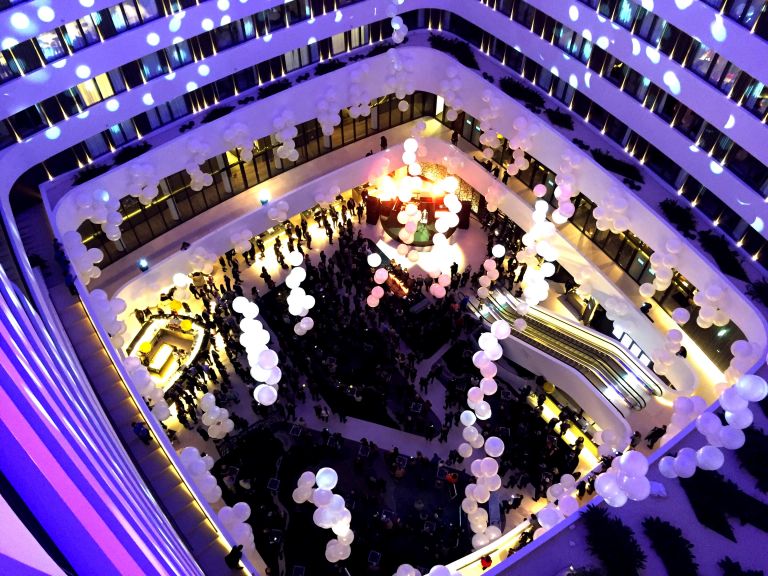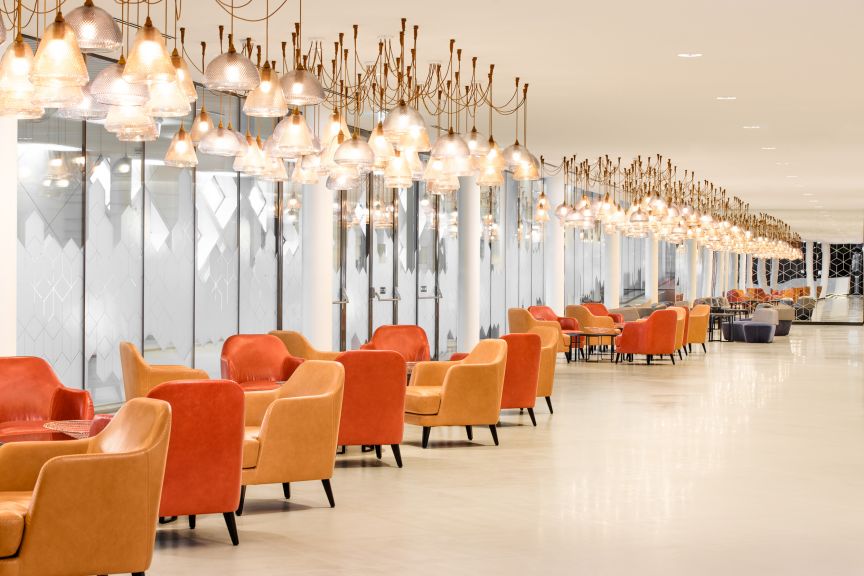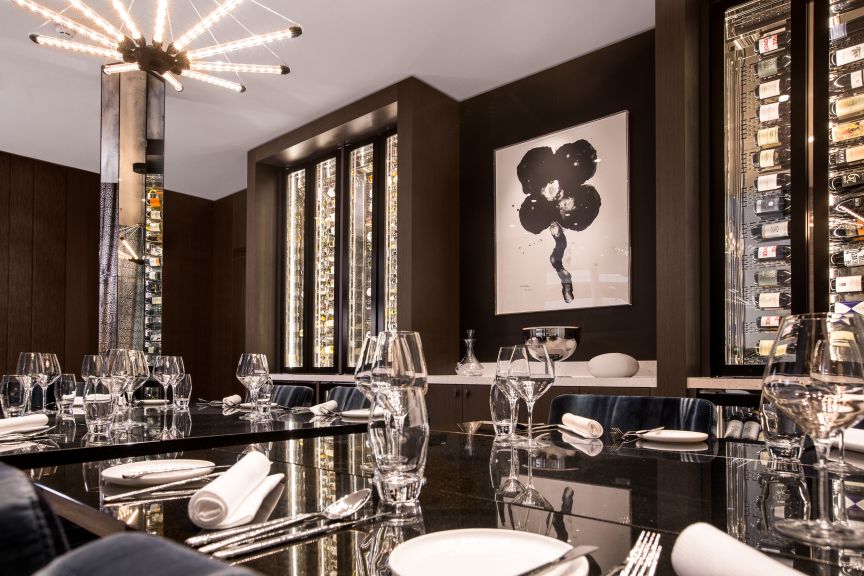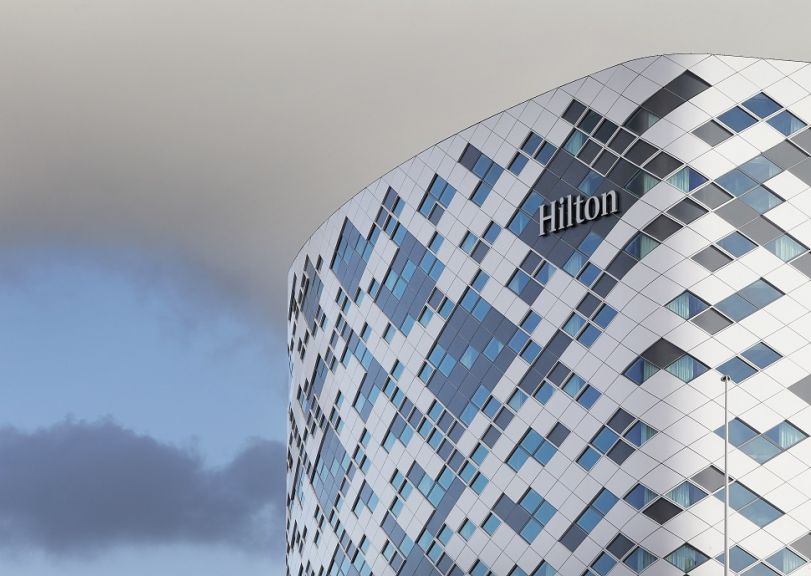Picture this: You’re standing beneath a towering atrium, buttressed on all sides by futuristic white balustrades, which lead to a massive skylight window floating far above. Psychedelic pink and purple lights fill the space, which suits the soft rock band performing on the corner stage just fine. You’d dance, but your colleagues are present, so you settle for fancy cocktails and conversation instead.




You’d think this was a luxury cruise line blowout, but instead, it is an airport hotel lobby – which hosted more than 800 guests attending the grand opening of the new Hilton Amsterdam Airport Schiphol this February. The shindig was funded by Amsterdam’s juggernaut investor and developer Schiphol Group, which is majority owned by the Dutch Ministry of Finance. Together, they’ve decided to invest heavily in the city’s airport complex, constructing new office buildings, new parking garages, and a futuristic Hilton hotel designed to embody their urban vision.
“Schiphol has an ambition: to be Europe's preferred airport,” Jos Nijhuis, CEO of Schiphol Group, announced to the mostly-corporate crowd of invitees. The company declined to reveal how much was invested in the new Hilton, but the business logic was made clear: “In 2016, we expect to welcome 60 million travelers at Schiphol,” he said, which would constitute record-breaking traffic.
Globally, more than 8 million people take to the skies every day, according to the International Airport Transport Association (IATA). Building better airport hotels might not be such a bad idea.
Several Dutch and British firms competed to win the Hilton contract, but in the end, the Schiphol group settled on Dutch architects from Mecanoo and interior designers from London’s HBA, both award-winning firms that specialize in high-end hospitality.
First, Mecanoo created the construction blueprint, which set out to build a fast, seamless connection between hotel rooms and the center airport hub. Now “the Traverse,” a sleek indoor walkway, connects air travelers to the Hilton in 7 minutes flat.
The next mandate was to create an iconic façade. “We didn’t want it to look like an office building. That was really important,” Mecanoo architect told Ellen van der Wal told ARTINFO during an on-site tour. “So, we created this cube structure, encased it in wraparound layers of diamond-shaped windows and turned it 45 degrees to distinguish it from its surroundings.” Indoors, 433 guestrooms, a conference center, health spa, restaurant and bar are all logically situated around the 42-meter atrium lobby with its stunning skylight roof.
Exploring the Cube
Outside the diamond shaped, soundproof windows of my hotel room, an intricate weaving of byways and highways weaved traffic in an out of airport terminals quietly. Behind me, a modern canvas of the Dutch landscape by artist Israel Páez held court above the headboard, a vast improvement compared to most generic airport hotel art.
“The Dutch design scene is very art focused. We wondered, with Hilton, how far can we take it?” said of HBA interior designer Constantina Tsoutsikou, passing a pop-up gallery of valuable Picasso oil reproductions outside the second-floor conference room. Contemporary artwork and silver sculptures commissioned by Schiphol appear on nearly every floor of this hotel, which is clearly determined to shake assumptions of mere utility.
In the lobby below, orange retro chairs and midnight blue couches from Dutch suppliers sit on individual carpet islands which, by day, host a buzzing work crowd accessing the internet at individual computer stations and drinking coffee during conference calls. By night, the lights dim and the entire lobby turns into a cocktail lounge, where young hotshot mixologists run a well-stocked gin bar, while an electronic DJ station spins popular pop songs in the background.
Throughout the hotel, there are myriad references to Dutch maritime history. “We focused on Dutch history with trade routes to create the aesthetic,” said Tsoutsikou, pointing out aqua blue chairs, royal blue lamps and walled tiles painting seafaring scenes. At the Bowery restaurant, and in the guest rooms, HBA has created a warm, cozy atmosphere, uncommon to airport hotels. You’ll find fresh tulips on the tables, soft gold lighting, and patterns of traditional Dutch embroidery blown up to scale in the carpets and on the bathroom walls. “You’re coming from somewhere and going somewhere else. Here, we wanted to create an authentic sense of place,” Tsoutsikou added. At this, they have succeeded.
There are, however, obvious snags, which the hotel is already scrambling to rectify. The building’s air controls are not working properly (after freezing under three blankets for several sleepless nights, there was still no solution despite multiple visits from the in-house technician.) Furthermore, this Hilton is understaffed. “We're currently hiring. Now we’re 150 and need to be 170. We didn't expect the hotel to take off so fast,” Marije Bekker, Director of Business Development, Hilton Worldwide told ARTINFO.
These glitches are, however, fixable - the common growing pains of a grand new venture. On the whole, the imaginative concept and out-of-the-box execution of this hotel makes it a must for design fanatics and time-crunched travelers alike.
Hilton Amsterdam Airport Schiphol: Rates start at 219 euros per night.

